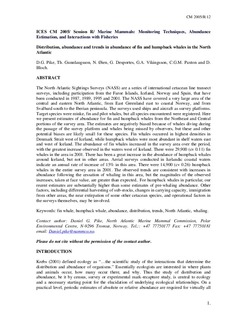| dc.description.abstract | The North Atlantic Sightings Surveys (NASS) are a series of international cetacean line transect surveys, including participation from the Faroe Islands, Iceland, Norway and Spain, that have been conducted in 1987, 1989, 1995 and 2001. The NASS have covered a very large area of the central and eastern North Atlantic, from East Greenland east to coastal Norway, and from Svalbard south to the Iberian peninsula. The surveys used ships and aircraft as survey platforms. Target species were minke, fin and pilot whales, but all species encountered were registered. Here we present estimates of abundance for fin and humpback whales from the Northeast and Central portions of the survey area. The estimates are negatively biased because of whales diving during the passage of the survey platform and whales being missed by observers, but these and other potential biases are likely small for these species. Fin whales occurred in highest densities in Denmark Strait west of Iceland, while humpback whales were most abundant in shelf waters east and west of Iceland. The abundance of fin whales increased in the survey area over the period, with the greatest increase observed in the waters west of Iceland. There were 29,900 (cv 0.11) fin whales in the area in 2001. There has been a great increase in the abundance of humpback whales around Iceland, but not in other areas. Aerial surveys conducted in Icelandic coastal waters indicate an annual rate of increase of 15% in this area. There were 14,900 (cv 0.26) humpback whales in the entire survey area in 2001. The observed trends are consistent with increases in abundance following the cessation of whaling in this area, but the magnitudes of the observed increases, taken at face value, are greater than expected.. For humpback whales in particular, our recent estimates are substantially higher than some estimates of pre-whaling abundance. Other factors, including differential harvesting of sub-stocks, changes in carrying capacity, immigration from other areas, the near extirpation of some other cetacean species, and operational factors in the surveys themselves, may be involved. | en |
